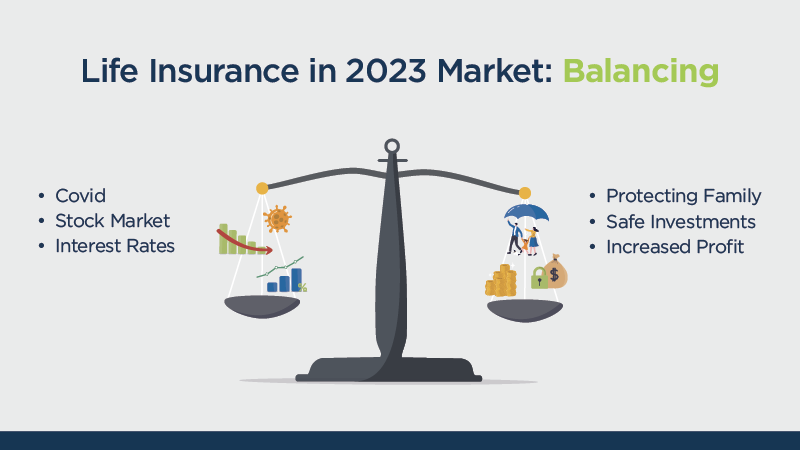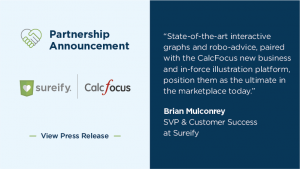New Sales, Premium Growth, and the Market Variables at Play
Following a 40-year high in life insurance sales in 2021, 2022 saw reasonable success as well. Despite a decline in the third quarter, LIMRA reported that new premiums in the first nine months of 2022 were still 6% higher than reported for the same period in 2021.
I believe the significant growth we have seen over the past two years is the result of mortality reminders such as COVID-19 and other respiratory viruses (my family caught all of them) mixed with a plummeting market. In my experiences and conversations, it seems as though these factors encouraged people to look for safer investments, ultimately driving life insurance and annuities sales.
I foresee 2023 as a year that will be similar to 2022. Even with continued fears of a longer term recession, high-interest rates, and the potential for both to cause consumer cash issues, these detractors for the L&A industry just may be offset by consumers’ new acknowledgment of their own mortality, a shift to safer investment products, and the insurer’s ability to drive higher profits on higher interest rates.
Direct-to-Consumer (DTC) and the slow adoption by both consumers and insurers
For the last five years, direct-to-consumer (D2C) players have received the lion’s share of hype and attention from the market on most fronts. Thus, there was, and is, a lot of pressure to “go digital” to meet the expected flood of customers waiting to buy anything and everything on their digital devices. That belief may or may not be accurate, but this new breed of digitally-enabled insurers have clearly helped motivate many traditional life insurers to stop thinking about the possibilities and finally move forward with the digital enablement of the life unit (annuity hasn’t moved much, yet). Alas, it also exposed a laundry list of bottlenecks within legacy systems that have curtailed many of these enablements (another important subject to be tackled later.) The reality is that this pressure has driven good progress for the industry, but it has not been the “be-all and end-all” that many believed it would be – and the numbers show a clear story.
As of January 2023, less than 10% of life insurance, and almost no annuities, are bought direct-to-consumer. Additionally, the trend of buying online has only shown single-digit growth rates year-over-year. Beyond missing the hype, though, I think there is more to the evolving story of potential. We can extrapolate from these statistics that, by 2030, the number of digitally distributed life products could reach 25%. Truth is, many haven’t started true digital enablement, and the slow rise of the consumer direct buyers might be exactly what traditional life insurers need to catch up. From what I see and hear, even those offering D2C sales offer very few of their products online compared to what they carry on the shelves of their agent channels (5% in many cases). In all, with the possibility of digital sales at 25% in 7 years, no one should be sitting on their hands while this digital makeover continues to progress.
Insurtechs Running to the Agents
As a result of the challenges in D2C and digital buying growth numbers tapping out, there has been a major shift by the D2C insurtechs to create agent solutions that drive more efficient premium sales (as this is all the market now cares about). The insurtechs – which you may have thought of as exclusively D2C – have literally all recently entered the agent space on some level. Some of the biggest efforts include Ladder Life (which added Ladder for Advisors), Ethos (which created Ethos for Agents), and PolicyGenius (with PolicyGenius Pro for Agents). We are only going to see more of this expansion take place on the traditional insurers’ turf as the insurtechs attempt to increase their revenues by going where 90% of life premiums are actually sold today. Yes, no surprise, that means traditional insurers continue to own the market, but they will need to stay vigilant year over year and not let new tech players sneak in through the backdoor with superior digital solutions for agents and producers. In all, don’t sleep on providing next generation agent solutions.
Life-Focused, Value-Added Services Are Here to Stay
It’s clear and has been clear for years that life insurers have a major opportunity to offer much more than a death benefit and a bill. Many have started to offer new value-added services and products for both new customers and in-force policyholders alike. I believe the trend really started with John Hancock’s Vitality program and its offerings around health, but today, there is a wide and growing range of offerings – Haven Life Plus, Ethos‘s partnership with Aaptiv, Headspace, and SHRED, the purchase of Tomorrow’s will and trust product, and New York Life‘s affiliation with Empathy for beneficiary support. The list seems to be growing every day, and everywhere we look we see new offerings emerging to add value to the policyholder of yesterday (in-force) and the prospective policyholder holder of tomorrow.
Insurers do, at times, struggle to wrap their heads around this constant drive toward modernization due to their history of a death benefit and a bill being “good enough.” But the focus is rather simple. The insurer’s offering should centralize around themes and the psychology of “life” that drives people to buy life insurance in the first place. Yes, the textbook reason for life insurance is to protect loved ones financially at death, but what does that mean in the time between a purchase and the claim – in other words, life? So far, the offerings are logical “value adds” in a few practical categories: financial wellbeing, physical health, risk reduction, and psychological security in the event of a death. The possibilities go far beyond these, though. If you’re looking for a way to add value, these themes offer a great place to start your search.
Keeping an Eye on the Market
Both public and private market action caught my attention over the last 12 months. Corebridge (formerly AIG Life) went public in September 2022– and was the year’s biggest IPO. F&G’s IPO followed in December. These deals and expectations of other such transactions have created an interesting time in the public markets, where technology companies stop going public and financial institutions take the stage.
On the private equities side, I still see and hear significant interest by private equity groups for acquisitions across life books and I have even heard of more buyers looking for books than books for sale. As financial institutions restructure and tweak market value drivers internally, many have been eager to sell books of business. These may be old books with balance sheet requirements, or bad books they don’t like to look at these days. We will see this continue as it always has. Today, however, I am very interested in watching to see if the buyers like Apollo, KKR, Bain, and Blackstone can do more than run these books off, and put their books to work with both digital & marketing strategies. This continues to look like a major opportunity…yet little to none has been done.
Of note, life companies are not necessarily shutting down their entire life business with the sale of a book. Rather, they often continue forward with a fresh book and/or greenfield underwriting and a novel technology approach. In some cases, by getting rid of old books, carriers can more quickly develop new products, run away from the legacy tech challenges inherent in their old books, and grow their business from a clean slate…or at least that is the goal.
Chasing the Point of Sale
Embedded insurance is all the rage, and yet I don’t think it has taken off like the articles and panels have. I still see it as a major opportunity – one that has to be built partnership by partnership and with much better tech. Practically, I see this as being no different from an agent who calls on his or her neighbors, or who has an office on a busy street. Ultimately, it is about being there or showing up in someone’s life at the exact moment when and where it makes sense to buy or sell. Today, it has become clear that many people would rather sit in their homes behind a screen than meet at a coffee shop or pay an office visit. More importantly, most manage their lives online. Thus, devices and digital service providers (e.g., Amazon, Safeway, Target) know much more about us than our local agent does.
Transparently, my daily interactions with insurers, personal research and industry analysis show that insurers intending to support “real” embedded products have a lot of work to do. They will need tech systems, processes, new products and underwriting transformation to actually make embedding comfortable from the consumer’s/buyer’s perspective. Yes, embedding means presenting a product at the perfect time digitally – but how that is done makes a big, big, big difference.
Some examples:
Acorns targets the younger demographic with an offer of savings and financial accounts. These parties are digitally native when it comes to banking and financial products, so embedding other related products (like insurance) makes sense. Then, Acorns presents life products and actually gives these younger customers a small amount of money to put back into their accounts with a purchase.
Ladder Life began multiple types of embedding with SoFi. They started slowly with a link, and then moved to direct embedding in the site. Since SoFi is a new bank that got its start by refinancing student loans, these users will inevitably be life insurance buyers in time. Since then, SoFi has grown exponentially and gone public and now offers a myriad of financial products, partnering on offerings like insurance. Today, Ladder appears to be the preferred, sole partner. In all, both technology and partnership are required for embedding.
I don’t observe much embedding happening within major insurers but there are a lot of possibilities there. It feels like a miss, and a waste of the brand they built.
If I were a traditional insurer, I would be asking what is needed for a real embedded product to work tomorrow in a partnership environment. What is the true answer to this question in regard to tech, product, underwriting, and partnership structure? It’s a long way off.
A New Core System is Emerging
It’s no secret that most internal problems and the excuses that follow the question “why not?” come from legacy systems. Yes, we have a few new policy admin systems and underwriting engines, but these are not yet transforming the situation or fully enabling carriers to reach for a bigger and better market. The reality is that L&A providers struggle with systemic antiquity, but this leads to a real opportunity in 2023.
The truth is, the new core systems aren’t helping to solve problems with real transformation, data access, management costs, and the ability to let go of the past and imagine the future. So we find ourselves adding another system to the stack every few years, spending tons to get a first product on, migrating some stuff in, ultimately adding another system to the managed systems list.
I believe “the new core system” is staring us all in the face, and it is not a traditional system of the past. This system starts by having the end in mind, one that unlocks all legacy system data without replacing them. It exposes a single API edge to any new or existing digital system. This system does not depend on a build-out of point-to-point APIs to get the data out of the 30 systems already in place, but rather accepts the data in any format from day one. The system also doesn’t depend on the old system to ingest new transactions right away (as this may take time) but rather can hold those transactions as a record indefinitely.
This is the new core system (some would call it a platform), and it both unlocks the system and data of the past while opening doors to any future one can imagine. At Sureify, we call it ”CoreCONNECT,” but we know this is just the first of many core system reinventions. These systems will become the new standard as the constraints of the past succumb to remarkable technological advancements and a new era of capabilities arrive.




